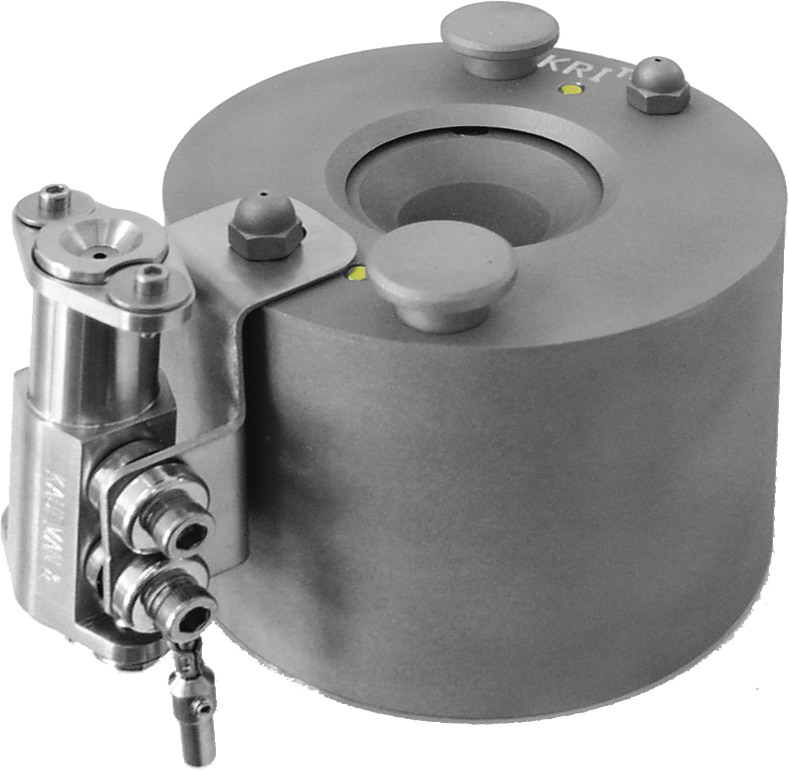Ion Sources
eH400
Home » Ion Sources » Gridless End-Hall Ion Sources » eH400
The EH400 is yet another successful ion source development from KRI, the originators and patentees of the Veeco-Commonwealth MKI / MKII ion sources. The original gridless ion source technology is now some 20 years old. However, development continued and in recent times has led to a radical redesign and improved ion source efficiency. A doubling of beam current and increase of operational range is the result. High performance ion beams can now be simply and economically integrated into most thin film deposition systems.
Due to its modular built the EH400 series can accommodate different anode systems to best suit your process. Thus even with the compact size of the EH400 model high beam currents can be achieved at lower energies.

Specifications
| Discharge power | 400 W max |
| Anode current | 3,5 A |
| Beam current | 875 mA max |
| Anode voltage | 40 – 300 V max |
| Mean beam energy | 35 – 210 eV |
| Gas flow | 1 – 50 sccm |
| Divergence | 60° |
| Operating pressure | up to 1 x 10-3 mbar |
| Height | 76 mm |
| Weight | 1,4 kg |
The eH400 is ideally suited to provide high ion current to small and middle sized vacuum systems. While recently upgraded to provide higher ion current, it is also a low cost solution for processes which do not demand the highest output performance in middle to large sized systems. The ability to control low ion energy and high current, the eH400 is successful with delicate materials such as plastic lenses and III-V semiconductors. It is commonly applied in ion assisted deposition processes, however, the eH400 has been popular in-situ preclean and low energy etching.

eH400F – Filament Version
This unit utilizes a robust tungsten cathode filament to provide both the plasma discharge and automatic beam neutralization. New design features enable the source to operate for extended periods with either inert or reactive gases.

eH400HCF – Hollow Cathode Version
This source is equipped with a new design hollow cathode electron source in place of the filament. Extremely long operational times are possible and the absence of a thermionic filament promotes a very high purity thin film environment.
Features & Benefits
Divergent Beam
From the plasma discharge, ions accelerate into a beam with a divergent ion current flux. The half maximum-half angle exceeds a 45º angle from the source axis. The divergent beam from an eH product covers a large area. The capability to uniformly cover a wide process zone facilitates high throughput operation, since a process run with a large load of parts or large substrate area becomes practical with an eH product.
Gridless
The eH product technology relies on a gridless construction. The ions accelerate directly from the plasma discharge to form the beam. The gridless eH technology complements our gridded ion source products, because it produces desirable beam properties not easily available with gridded sources. Other benefits of the eH gridless feature, include no need to maintain, align or replace grids. The eH products are rugged and simple to operate. And they typically cost less than their gridded counterparts.
High Density DC Discharge
The sources utilize a well-proven and efficient plasma generation process. In the discharge chamber, a cathode thermionically emits a reliable source of electrons. The electrons are attracted to a DC biased metal anode. The neutral gas species is efficiently ionized due to a confining magnetic field. This mechanism produces a high density plasma of many gases, including Ar, Xe, O2, N2 and other reactive gases.
Low Energy & High Current Output
The eH products output a high current and low energy beam. The high ion current meets critical arrival ratios for high process rates. Also, the high current enables productive processing on tough, hard materials. While the low energy ion bombardment eliminates damage to surfaces and interfaces. The capability to process at low energies has proven merit when working with delicate materials.
Non-immersed neutralizers
The standard neutralizer configuration is an inexpensive refractory metal filament stretched across the ion beam. The filament is heated to thermionic emission temperature. The filament neutralizer may be replaced with an alternative non-immersed neutralizer. The non-immersed neutralizer sits to the side of the source and outside the ion beam. When the neutralizer is outside the beam, the time between maintenance is significantly longer for the non-immersed neutralizer versus the filament neutralizer. This non-immersed configuration is suited for low frequency maintenance installations and long operational runs when it is important to minimize the risk of process interruption.
Quick Change Anode Module
The eH Product incorporates our patented quick- change anode module assembly. The anode module can be quickly removed from the ion source for maintenance, while the source body remains in the chamber. The anode module is light weight and interchangeable. By simply exchanging the working anode module with a spare module, the eH product can be ready to run within minutes. The removed anode module can be easily maintained on a work bench while your vacuum chamber continues to be productive. The uptime benefits are significant.
Stable Neutralization
The product line provides a dedicated and regulated electron source neutralizer. With a reliable source of electrons, the products can process dielectric, electrically isolated, and electrostatic sensitive substrates. The amount of electrons is precisely controlled to match positive charges. The correct amount electrons are present in the ion beam and they arrive at the substrate surface to provide an electrically neutral process. The operation does not need to rely on an ambiguous source of electrons such as exposed and conductive chamber hardware. Coating build-up and stray electromagnetic fields, which may be present in the vacuum chamber, will not disturb the ion beam quality, stability or neutralization of the products. However, in the case, when the neutralization process is not so critical, the products do allow operation without the neutralizer.
